Why have I produced a Canine Arthritis Bible?
To be brutally honest, initially, it was for purely selfish reasons. We had received the diagnosis for our dog, Harvey, and wondered ‘How do you and your dog survive canine arthritis?’.
If this resonates with you and you are wondering how you and your dog will survive then read on …
There are bits and pieces of information available on the internet but nothing seems to provide a comprehensive guide. So, I decided to produce a Canine Arthritis Bible that would outline the symptoms, treatments, and management of arthritis in dogs.
In Harv’s case, we’d noticed that although he was absolutely fine when doing the things he loves, like doing his best impression of Taz of Tazmania
We took him to the vets. There was nothing obviously wrong (and, in typical fashion, Harv wasn’t limping while we were there!) and so initially he had an injection for pain relief and we had a ‘watching’ brief.
The limp would virtually disappear for a while but then it would return.
X-rays confirmed that it was arthritis that was the problem.
Your vet has just told you that your dog has arthritis. That is, your dog has an incurable disease that is damaging his joints, restricting his movement, and could be causing him pain. What do you do?
Fear not. Whilst arthritis is, currently, incurable it is manageable. I hope that this Canine Arthritis Bible will be of some help to you and your dog.
Affiliate Disclaimer
1 Definition of Arthritis
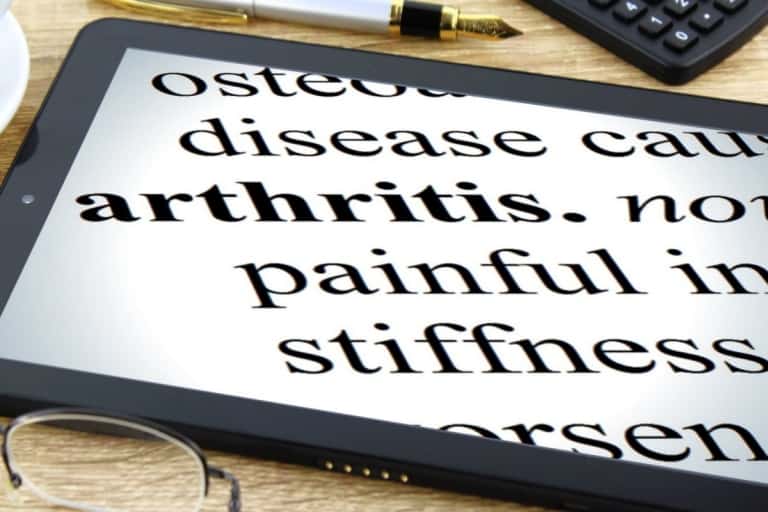
So, what is arthritis?
Medical terminology
As with many medical terms the name is derived from Latin.
- Arthro means a joint.
- Itis means inflammation of a specified part.
Therefore, combining the two gives us “joint inflammation”.
Simple explanation
In plain English, it means that there is pain, swelling, and stiffness in one or more of the joints in your dog’s body.
2 Joints and the Impact of Arthritis
Osteoarthritis, or Degenerative Joint Disease, is the most common form of arthritis in dogs. It is the progressive and permanent deterioration of the cartilage surrounding the joints.
In understanding arthritis, therefore, we need to understand a little about how joints work.
A joint is basically the way that two separate bones are held together in a manner that permits a certain degree of movement – the major ones are shoulders, elbows, wrists, hips, knees, and ankles but it also includes the joints in fingers and toes.
Take a look at the image below for an example of a typical joint.
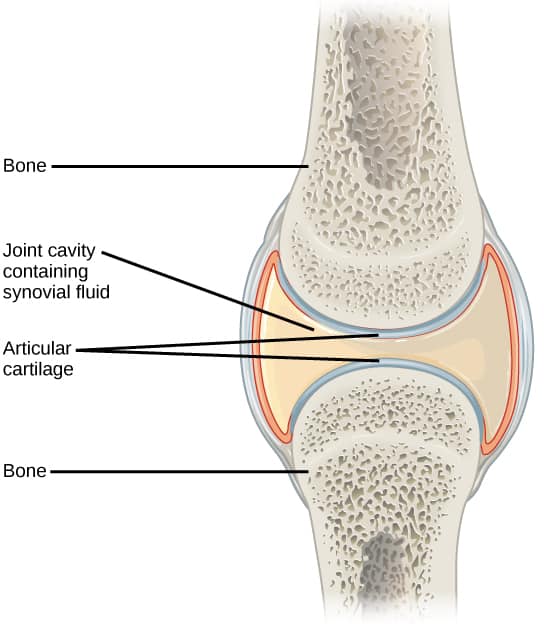
In healthy joints, there are layers of cartilage on the ends of the bones and there is also a cavity filled with fluid (synovial fluid) . The cartilage and fluid combine to provide a mechanism for keeping the bones apart so that they smoothly glide past each other without any friction.
In joints that are suffering from arthritis there is a deterioration of the cartilage and it begins to break down. The matter is compounded by bony growths (osteophytes) developing on the ends of the bones in the joint concerned.
The situation is further exacerbated by the fact that the arthritis also affects all structures in the synovial joint, not just the cartilage.
The overall result is pain, swelling, and mobility issues.
Unfortunately, the body is not very good at self-repairing the damage (researchers believe this is most likely due to the poor blood supply to the areas concerned).
3 Symptoms of Canine Arthritis
OK, so we now know what arthritis is but:
How do you know when your dog has arthritis?
For those of you that haven’t yet visited your dog’s vet but are wondering whether your dog may be affected by arthritis here are some typical symptoms to look out for. If your dog has one or more of these it would probably be prudent to consult with your dog’s vet to obtain a diagnosis.
- Stiffness and or limping. If your dog struggles for a moment (or longer) when he first gets up and seems unsteady on his feet, or if he walks with a limp, then this may be a consequence of joint stiffness or pain which is a result of arthritis.
- Swollen joints. Depending on the joint concerned you may actually be able to see that it is swollen compared to its normal size.
- Reluctance to perform common activities. Has your dog started to become reluctant to jump in and out of your car, or walk up or down steps or stairs? Or even reluctant to go for a walk. Joint pain could be the driver of this change.
- Unable to get comfortable. Does your dog move around a lot because he is unable to get comfortable in a particular position or location?
- Avoidance. If your dog feels uncomfortable he may try to avoid any contact from you, or anybody else. He may even growl at you if he is in a great deal of pain.
- Vocalising pain. Is your dog whimpering, crying, or whining when moving about?
- Constant licking. The constant licking of a particular joint can be a sort of self-soothing activity for your dog if he is in pain or discomfort.
- Loss of appetite. If your dog is in pain from arthritis then he may well not feel like eating as much. This is a common sign of arthritis.
- Out of sorts. This is a difficult one to describe. You know your dog better than anybody else does. Does he just seem ‘off’ recently? If so, get him checked out – it could be arthritis or it could be some other medical condition. Better safe than sorry.
4 Causes of Canine Arthritis
We now know what arthritis is and the symptoms that may indicate its presence.
The next thing people often want to know is:
Why has my dog developed arthritis?
There are a number of potential causes. The primary ones are as follows:
- General wear and tear
a) Age. Arthritis can affect younger dogs but it is far more common in older dogs. The reason is simple – older dogs have more miles on the clock and this leads to general wear and tear.
b) Weight. It is also more common in dogs that are overweight – the increased weight places unnecessary strain on the joints.
c) RSI. Repetitive stresses on joints are also a factor. These include activities such as flyball, agility, and dock diving. - Injuries
Injuries, such as fractures or ligament tears, that occur earlier in a dog’s life can increase the risk of arthritis occurring in later life. - Genetic predisposition
Unfortunately some dogs are just more likely to develop arthritis regardless of age or previous injuries. These are typically, but not exclusively, larger breeds of dogs such as Labradors, German Shepherd Dogs, Golden Retrievers, and Rottweilers.
These dogs often have an increased risk of developing elbow dysplasia or hip dysplasia. These conditions are problematic enough in isolation but they typically increase the risk of the dog also developing arthritis in the joint(s) concerned. - Infections
Certain infections (such as Lyme Disease) can affect the joints. - Poor nutrition
Thankfully quite rare these days as the dog food manufacturers have gone to great lengths to create well balanced diets. If you decide to DIY with your dog’s diet you should ensure that you are feeding a balanced diet that addresses all of your dog’s needs.
5 Diagnosing Canine Arthritis

First things first. As knowledgeable as you may be (or your dog walker, a friend who has always owned dogs since she was 5, man down the pub) the only person that can really make a diagnosis is your dog’s vet.
So, if you think that you have identified some symptoms go and discuss them with that person.
The vet will discuss the symptoms with you and carry out a physical examination of your dog. They’ll be looking for a decreased range of movement, stiffened gait when walking, and any swelling or deformity in the joint(s).
To fully investigate the position it is likely that the vet will want to take x-rays of the affected joint(s). X-rays can help to identify the things that we discussed above in the ‘impact of arthritis’ section and possibly the underlying causes too.
Sometimes the vet may also recommend taking a sample of blood and a sample of the joint fluid to enable further tests to be undertaken.
This may all seem like a lot to put your dog through but the more information that you, and the vet, have the more informed your decisions can be in terms of what to do for your dog.
6 Surviving Canine Arthritis
There is currently no cure for arthritis – in dogs or in humans.
However, there are plenty of things that can be done to help your dog survive canine arthritis and to live the best life possible. We’ll cover the symptoms, management, and treatments relating to arthritis in dogs.
So, let’s take a look at the Canine Arthritis Treatments for dogs or CATs for dogs as I like to think of it!
6.1 Medical – drugs

Steroids
There are two main types of steroid:
- Anabolic steroids – these increase muscle development. These are the ones that you see in the media in relation to athletes.
- Corticosteroids – these are involved in the stress response within an animal.
The use of corticosteroids, such as hydrocortisone, prednisolone and dexamethasone, will certainly reduce swelling and inflammation, and thereby reduce pain, in arthritic joints.
Unfortunately, it is now recognised that steroid use can have disadvantages too in the long-term treatment of arthritis in dogs. As a consequence, most vets no longer prescribe them, or only very rarely.
A key disadvantage that is now known is that steroids can actually result in additional joint damage!
Other disadvantages include:
- Increased appetite (which can lead to obesity, thereby further damaging joints)
- Immunosuppression (less effective immune system)
- Muscle wasting
- Skin thinning
- Hair loss
- Abortion
- Muscle weakness
- Sodium retention
- Potassium loss
- Calcium deposition in skin or lungs
- Ulcers of the mouth, stomach and intestines
NSAIDs
When it comes to medication for dogs suffering from arthritis the most common choice is Non-Steroidal Anti-Inflammatory Drugs (NSAIDs).
NSAIDs help reduce swelling, inflammation, and pain in joints.
The most common examples prescribed for dogs are:
- Carprofen (Novox or Rimadyl)
- Deracoxib (Deramaxx)
- Firocoxib (Previcox)
- Meloxicam (Metacam)
NSAIDs are safe for the majority of dogs but they can have side-effects so you need to be aware of what these are and keep an eye open for them.
The most common side effects are:
- Anorexia
- Vomiting
- Diarrhoea
- Black tarry stools
- Change in drinking habits
- Change in urination
- Lethargy
If you notice any of these then immediately stop giving the drugs and consult with your vet.
The Food and Drug Administration (FDA) in the USA has produced some guidance on this issue.
Cartrophen
Cartophen is an injection that is given to your dog by the vet. Typically a series of 4 injections are given at weekly intervals.
To quote the manufacturers website “Cartrophen Vet (100mg/mL pentosan polysulfate sodium) is a prescription-only, injectable, sulphated sugar of plant origin. It is therefore classified as a disease-modifying osteoarthritis drug (DMOAD).”
Full details can be found on the Cartrophen website.
There is a similar drug in the USA called Adequan.
The body, be it human or dog, is very poor at repairing cartilage. These treatments look to help the process.
Our dog Harvey has had a course of Cartrophen, together with some dietary changes (see later), and he has shown marked improvement.
Librela
Librela is a fairly new treatment (released in the UK, Switzerland, and the EU in early 2021) but is already creating quite a buzz on social media among owners of dogs with arthritis.
The active substance in Librela is a monoclonal antibody called bedinvetmab. This substance is designed to recognise and attach itself to a protein called nerve growth factor (NGF). Once it is attached it interrupts the transmission of pain signals.
As with Cartrophen, the Librela solution is used by giving an injection. The dosage of the solution will vary depending on the dog’s weight. The injection is given on a monthly basis.
Note that Librela is not, as some enthusiasts have proclaimed, a cure for arthritis. What it does, and appears to do very well, is to provide pain relief for dogs suffering from arthritis.
Human drugs
It should go without saying.
But I’m going to say it anyway.
For example, you might be tempted to give human NSAIDs, such as Ibuprofen, to your dog. These are too toxic for dogs AT ANY DOSE.
Don’t let your desire to ease your dog’s pain cloud your judgement – using human drugs on your dog could kill him.
6.2 Medical – treatments
Not all dogs are able to make use of the various drugs that are available. Some dogs, for example, may be intolerant to NSAIDs.
Surgery
If the extent of arthritis in your dog is such that the pain is severe and constant then it may be that surgery is the best option.
These surgeries include joint fusion (Anthrodesis) or replacements.
Obviously, a complete fusion will mean that no movement is possible with the joint. But it will stop the pain. This is considered to be the last resort option.
Hip joints are not suitable for the fusion procedure but they are suitable for replacements.
These are complex procedures and you may require a referral from your vet to a specialist clinic.
Laser
The use of a therapeutic laser is a newer form of treatment that stimulates blood flow to tissues and can greatly improve arthritic conditions.
This is not a treatment that is commonly available at most vets – you would need to seek a specialist practitioner.
The treatment has a number of things in its favour:
- No need to shave the area to be treated
- No need for sedation before the procedure
- There are no side effects
The American Kennel Club has an article on laser treatment.
Note that cold laser therapy treats the surface of the skin, while hot laser therapy treats deeper tissues.
Acupuncture
Acupuncture is a treatment derived from traditional Chinese medicine. Very fine needles are inserted at various parts of the body. These needles are used to stimulate sensory nerves under the skin and in the muscles of the body.
The effect of this stimulation is to create various substances, such as endorphins, within the body. It is these substances that are responsible for the beneficial effects that patients experience.
It should be noted that there is no scientific foundation for the practice so it is often referred to as a form of Alternative Medicine.
That said, it is used by many reputable health institutions. For example, in the UK the National Health Service (NHS) uses it to help with the treatment of joint pain, dental pain, and migraines.
And there have been indications that acupuncture can help with pain relief in arthritis sufferers.
Massage
Massage therapy can be a very valuable mechanism for the treatment of arthritic dogs. It can:
- Slow down the degeneration of joints
- Reduce muscle tension, thereby relieving the pain of arthritis
- Stimulate blood flow
- Make your dog happy – they typically enjoy the process and the opportunity for bonding
Sessions should typically be around 10-15 minutes a couple of times a week. That said, there are no side effects so if you want to do 5 minutes a day every day then that is fine.
Things to consider:
- Think about attending a canine massage course, or at least do some reading up before you start
- Don’t overwork a particular joint – you don’t want to make the inflammation worse
- If your dog shows any discomfort – stop
- Massage around the affected joint, not directly on it, using long strokes or a kneading motion
- If you don’t feel able to do it yourself, find somebody suitably qualified to do it for you
Somebody with a great deal of experience in this area is Tim Norris. Tim was kind enough to provide the following quote:
“One of the most important things I’ve personally seen many times that I would like to share with you, after spending 15 years working with Arthritic dogs as a Rehabilitation Practitioner and Acupuncturist, is …
Tim Norris
… once you can get the family involved with the Arthritis Care for their dog, you have the best chance of getting the best possible outcome for their dog.
I’ve seen this play out countless times and the joy and sense of empowerment it brings to the families, knowing they are actively involved in helping their own dogs live the longest pain free lives possible.
Often spending as little as just 5 minutes a day using some simple Massage techniques or using a Heat Pack can make a life changing difference for your dog.”
If you take a look at Tim’s site, Both Ends of the Lead, you’ll find lots of useful information and a free pdf guide. He also produced the following video guide.
You can also see canine massage in action in the following video with Victoria Stilwell:
Heat pads
Being wet and cold is not good for arthritic dogs.
When your dog has finished swimming, or you’ve got back from a walk in the rain, make sure that you thoroughly dry your dog.
If you are going on a walk where you know that your dog will get wet then you could take a drying coat to put on after the swim. This helps to dry the dog before you return home.
You can further ease the pain caused by cold and wet by making use of a
Something else to consider is a hot water bottle wrapped in a towel. Again, probably not a good idea for the chewers!
Ultrasound
A probe is used to send high energy sound waves into the chosen area of the body. As the waves are absorbed they generate heat.
This heat helps to reduce inflammation and provide relief from the pain of arthritic joints. The mechanism for these effects is not currently clear.
Stem cell treatment
In simple terms, this involves harvesting a sample of stem cells from the dog, growing them in a laboratory, and then injecting them back into the dog at the site of the arthritic joint.
The stem cells then facilitate the repair of damaged joints by forming new tissue such as cartilage, tendon, and bone.
Many owners have found the results of this process to be very pleasing, as reported here in The Scotsman.
Platelet-Rich Plasma (PRP)
Blood plasma contains red blood cells, white blood cells, and platelets. The main use of platelets is in blood clotting but they also produce growth factors used in healing.
This treatment involves taking a blood sample and then removing the red and white blood cells to leave platelet-rich plasma (PRP).
The PRP is then injected back into the body at the site of the arthritic joint. It is believed that the PRP then helps to repair the damaged joint, especially the cartilage.
6.3 Diet and Supplements
Weight management
Weight is an important factor in managing arthritis in your dog.
All other things being equal, having less weight on a painful joint is preferable to
Even just shaving off a few pounds can make a big difference.
So, if you don’t already know the current weight of your dog – weigh him! Then establish how much he should weigh. Then determine whether he needs to lose some weight.
If you don’t know how much your dog should weigh here are a few links which may help:
Listed below are the weights for some of the most popular breeds:
| Breed | Male (kg) | Female (kg) |
| Labrador Retriever | 29-36 | 25-32 |
| German Shepherd | 29-41 | 23-32 |
| Golden Retriever | 29-34 | 25-29 |
| French Bulldog | < 13 | < 13 |
| Bulldog | 23 | 18 |
| Beagle | 9-14 | 9-14 |
| Rottweiler | 43-61 | 36-45 |
| Yorkshire Terrier | 3 | 3 |
| Boxer | 29-36 | 23-29 |
| Great Dane | 63-79 | 50-63 |
Keep in mind that the above are just general guides. Each dog is different.
If you still aren’t sure then you could use the generic ‘bed linen’ test. Feel the covering of flesh over your dog’s ribcage. How does it feel?
- Sheet – too thin
- Blanket – just right
- Duvet – too fat
For the sake of your dog, you should be honest with your assessment.
If you know, in your heart of hearts, that he is too fat then you need to help him lose weight.
Supplements
The use of supplements may only provide modest benefits to your dog in terms of coping with arthritis.
• If you can make a modest benefit compared to making no benefit at all why wouldn’t you?
Why not try them for a while and see if you notice any improvement in your dog? If they help, fantastic. If they don’t, stop using them and perhaps try something else.
It would be prudent to test the supplements individually. If you try two or more at the same time you won’t be able to tell where the benefit is being derived.
So, let’s take a look at what is available.
Glucosamine and Chondroitin
Glucosamine is a natural compound found in healthy cartilage, particularly in the fluid around the joints.
Similarly, Chondroitin is also a major component of cartilage.
Each of them can be found within various animals or can be made in a laboratory.
For a great alternative to supplements when looking to give your dog Glucosamine and Chondroitin consider making some Bone Broth instead.
Studies have shown that each of these supplements provides pain relief for sufferers of arthritis.
The caveats are that the pain relief is only moderate and that it works quite slowly – taking around 3 months of use before the benefits are felt.
Unfortunately, other studies have shown that there is no greater benefit than if a placebo were taken.
The bottom line is that in some cases these supplements may provide modest pain relief if used for a prolonged period (greater than 3 months).
Omega-3
Omega-3 is a family of fats.
They come in 2 forms:
- ALA (alpha-linolenic acid).
ALA can’t be manufactured by the body so it has to be eaten. It is found mainly in vegetable oils, nuts, and green leafy vegetables. - EPA (eicosapentaenoic acid) and DHA (docosahexaenoic acid)
These can be manufactured by the body. That said, the process is slow and it is still probably best to obtain them through diet. Oily fish and green-lipped mussel are considered to be good sources of EPA and DHA.
Omega-3 may curb stiffness and joint pain. Furthermore, they also seem to boost the effectiveness of anti-inflammatory drugs.
You don’t necessarily need to buy Omega-3 supplements – you could just make changes to your dog’s diet to include things like fatty fish.
YuMove
YuMove is a joint supplement for dogs.
Its ingredients include Green Lipped Mussels (a strong source of Omega-3) and Glucosamine.
We’ve been giving this to Harvey ever since his diagnosis and, in combination with other actions, it has hugely improved his condition.
Turmeric / Golden Paste
Turmeric is a very brightly coloured spice. Thanks to a compound it contains, called Curcumin, it has lots of amazing benefits:
- An excellent anti-inflammatory
- A brilliant anti-oxidant
- May provide protection from toxins and even cancer
The Arthritis Foundation discusses it here.
And test results can be found here.
Curcumin in isolation is difficult for dogs to absorb. It, therefore, needs to be combined with something else to aid absorption.
Typically this is an oil, like coconut oil.
In addition, it has been found that the absorption can be increased significantly (2,000%!) if combined with black pepper. This is because of a phytochemical in black pepper called peperine.
Keep in mind that the bright yellow colour is likely to stain anything that it comes into contact with – including your hands and your dog’s mouth. Mix it well into his food.
There are various forms in which your dog can take curcumin. These include tablets, a pre-made Golden Paste mixture, or chews.
Or you can go the DIY route. A popular recipe can be found here.
Cannabis Oil
Cannabidiol (CBD) is contained in cannabis and has been found to relieve pain.
Although there have been no studies in dogs yet to confirm this it is has been shown to be the case in rats.
This hasn’t stopped some dog owners from pushing ahead with the treatment and there is growing anecdotal evidence that CBD is very effective in pain relief and has no side-effects.
The downsides are that it is illegal in some
In addition, there are unscrupulous suppliers who provide products that don’t actually contain any CBD.
You can read more at PetMD here.
Until such time as there has been more testing and the
Diet

There are two key objectives with diet:
- Weight management
- Reducing inflammation
Our objective from a dietary perspective is to reduce inflammation.
There are a few foods that have anti-inflammatory properties and which you can consider adding to your dog’s diet. These are:
- Animal-based omega 3 fatty acids, like those found in fatty fish. It doesn’t even have to be fresh (although that is preferable) you could just use a tin of sardines. As an added bonus, these fatty acids are good for your dog’s skin and coat too.
- Berries. These contain high levels of anti-oxidants and are brilliant at fighting inflammation. They also contain silicon and this may be able to assist with bone and connective tissue growth, thus helping your dog’s joints to fight off the effects of arthritis. Blueberries are especially good.
- Papaya. Papaya has anti-oxidant properties that help to prevent damage to cells.
- Mangoes have similar properties to papayas and can also help fight the pain of arthritis.
- Sweet potato. Sweet potatoes contain beta-carotene and this can reduce inflammation. Furthermore, the amino acids that they contain help to build muscle. This is helpful as it provides support to weakened joints.
- Celery. Celery is another anti-inflammatory but is also very low in calories, thus reducing any concerns about increasing weight.
- Turmeric. Turmeric contains circumin and other anti-inflammatory compounds..
- Coconut oil. Coconut Oil is another natural anti-inflammatory.
- Ginger is in the same family as turmeric. It also contains a substance (gingerol) that is able to prevent inflammation.
Don’t go overboard and give your dog all of these at once! Variety is the spice of life.
We’ve discussed what dietary additions might be useful, but what about things that should be reduced?
It may be beneficial to cut-down on the following:
- Carbohydrates
Look to reduce ‘nightshade vegetables’, which include potatoes, tomatoes, and aubergine (that’s eggplant for readers in the USA), and also reduce grains, including wheat, rice, barley and corn.
These types of carbohydrate increase inflammation and therefore exacerbate the situation for dogs with arthritis. - Fats and oils
Fats are a risk because they are very calorific. This means an increased potential for weight gain if eaten to excess.
And we know that weight gain is something to avoid (link).
Certain fats also increase inflammation providing a double-whammy to your poor dog.
Oils like sunflower oil and vegetable oils are bad because they contain Omega-6 fatty acids which increase inflammation. - Fatty proteins
Our dogs need protein to help build muscle, which in turn relieves pressure on arthritic joints.
However, certain protein sources are also high in fats that contain the aforementioned Omega-6 fatty acids.
So, look for lean sources of protein rather than fatty ones.
6.4 Lifestyle
It is said that you can never truly know somebody until you have walked a mile in their shoes.
Well, try to look at things from your dog’s perspective.
He has chronic joint pain and sometimes struggles to cope with the things that he previously did with ease. What can you do to help?
Look at where your dog sleeps
Can you buy him a comfier bed? A nice thick one made with memory foam perhaps.
We bought two for Harvey:
- A Petfusion memory foam bed for in the lounge (he normally gets up on the sofa between me and my better half but if he has had a bad day with his arthritis he will take himself to this bed).
- A memory foam base for the base of his crate so that he is comfortable at night (or when he uses it during the day).
Does he struggle to get in and out of your car now?
Consider getting a ramp to make access easier.
We haven’t, yet, got a ramp for car access so I can’t recommend a specific product. Ask around to see if anybody that you know uses one. Or ask on a forum like My Labrador Friends.
Failing that you could try the popular ramps on Amazon.
Do you have slippery floors?
Dogs with arthritis can have weakened muscles making it difficult for them to balance on slippery floors. Slipping on such surfaces can cause further injury to your dog.
Consider getting some anti-slip mats or rugs for the areas that your dog uses.
Stairs
Going up and down stairs or steps will put increased pressure on your dog’s joints. Look to make layout changes that avoid the need for your dog to use them. Consider using a stair-gate to prevent access.
6.5 Exercise
Don’t make the mistake of thinking that, in order to protect his joints, an arthritic dog shouldn’t have any exercise.
He still needs, and will enjoy, exercise. You just need to be careful.
In particular, you need to focus on low-impact rather than high-impact.
Walking (and even moderate jogging) is OK but watch the duration and intensity. Think more along the lines of a half an hour walk on a flat surface rather than two hours running up and down steep hills on rough ground.
Swimming, and under-water treadmills are good.
As are things like scent-training which give the dog a different focus for their energy.
Your objectives, in addition to making your dog happy, are to maintain the ideal weight, thus lessening the load on injured joints, and to help build and/or maintain muscle in order to better protect the joints.
Swimming
Swimming is fantastic exercise for your arthritic dog.
The big plus, of course, is that the water supports his weight. He can therefore happily exercise without putting anywhere near as much strain on his painful joints.
Not only that, but the swimming will help to build muscle, which in turn helps to provide more support for the joints.
Scent work
Humans have around 6 million olfactory receptors in their noses. Pretty impressive right?
Until you realise that dogs have 300 million!
Scientists have struggled to come up with an accurate estimate of how many times better this makes a dog’s sense of smell. The best analogy that they can come up with is this:
And how is a dog able to process all of this information? It has an olfactory cortex in its brain that is 40x bigger than
As you might imagine, therefore, when a dog gets to use its sense of smell it is doing something that it is very well suited to. But it doesn’t just have to be police or military dogs, or search and rescue dogs. Any dog can do it.
We do scent training with Harvey and it is fantastic. I’m constantly amazed at just how incredible a dog’s sense of smell is.
It’s an ideal activity for an arthritic dog – it is hugely mentally stimulating, great fun, and puts no strain on the joints. Perfect.
7 Summary
OK, let’s get the bad news out of the way first:
- There is no cure for arthritis.
- There is no ‘one size fits all’ miracle treatment that will work in every situation.
However, as we’ve seen, there are many things that you can do to help your dog cope with arthritis.
In working to put together our own particular jigsaw I posted a couple of online polls, one on the Facebook group Dogs with Arthritis and one on the My Labrador Friends forum, to see what worked for other people.
Take a look at the poll results below.
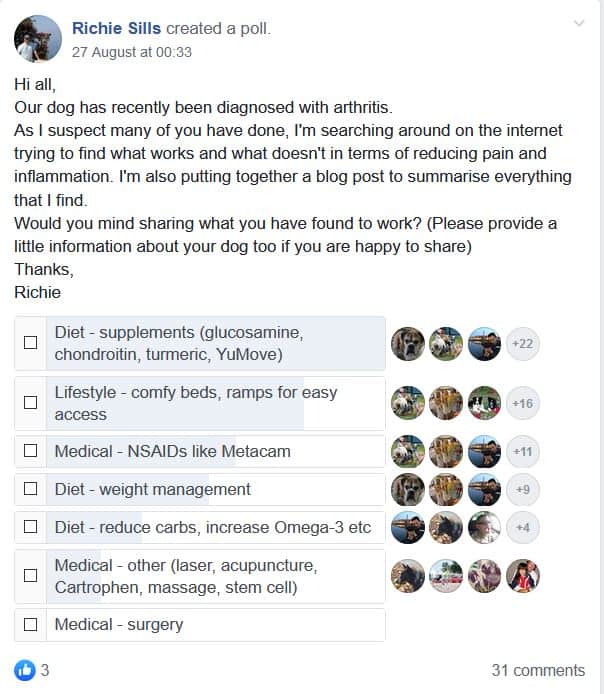

The results are broadly similar across the two polls but I’ve combined them into one chart to give an overall view.
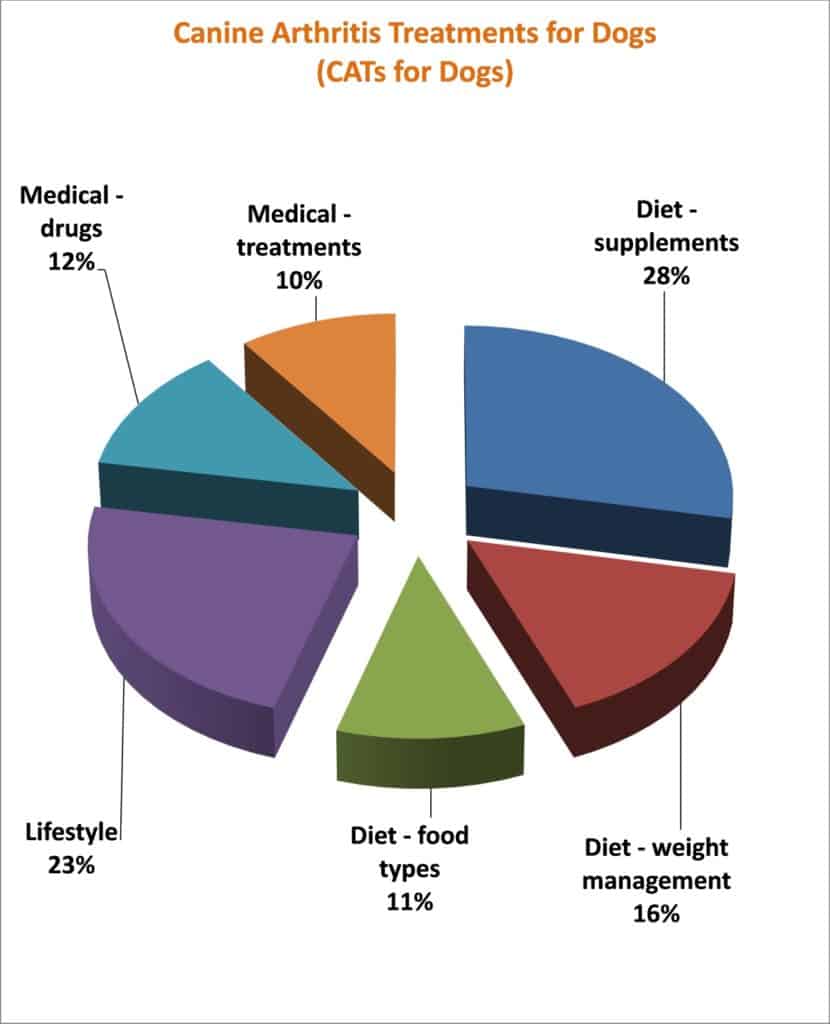
As you can see, over half of those that responded have had success with supplements and lifestyle changes. These are simple ways in which you can improve your arthritic dogs quality of life.
We have a fantastic vet. Not one of those where you get the impression that they are just looking to charge as much as they can. He is always looking at what is best for your pet.
In the case of Harvey and his arthritis we’ve agreed on a treatment plan:
- Continue with most activities as before but in moderation.
- Keep a balance between keeping him healthy and keeping him happy – there is no need for your dog to have a miserable life.
Here’s a quick summary in the form of an infographic:
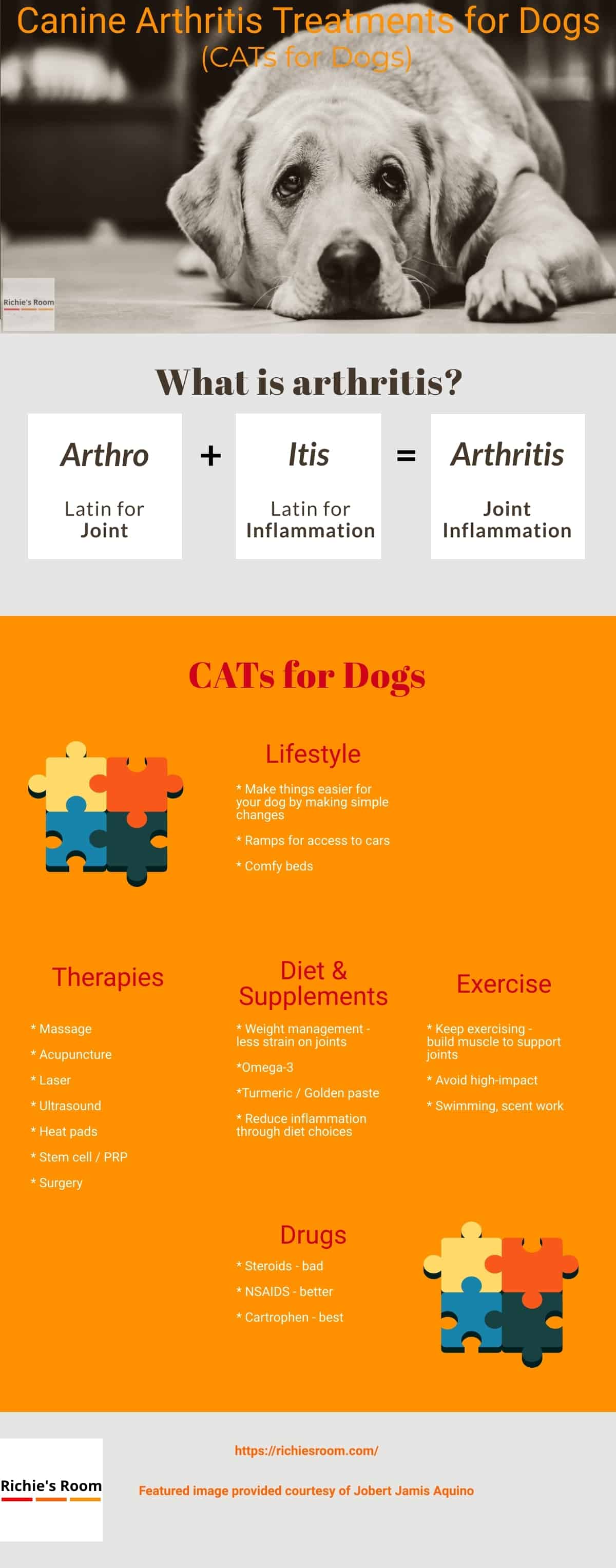
8 Frequently Asked Questions
What is canine arthritis?
From the Latin, ‘Arthro’ means joint and ‘Itis’ means inflammation of a specified part. So, Arthritis is joint inflammation. In plain English, it means that there is pain, swelling, and stiffness in one or more of the joints in your dog’s body.
How do you know if your dog is in pain from arthritis?
There are a number of symptoms that will indicate whether your dog has arthritis. A key one is limping or demonstrating stiffness when walking. Also, look for difficulty or pain when getting up, touch avoidance, constant licking, and lack of appetite.
What do you give a dog for arthritis pain?
For immediate pain relief see your vet for some painkillers. For non-vet options consider; heat pads (or hot water bottles wrapped in towels), massage, and even acupuncture.
Should you walk a dog with arthritis?
Arthritic dogs still benefit from exercise, including walks, as it helps to maintain muscle which lessens the strain on joints. More frequent, shorter walks are preferred to very long walks. Avoid high impact activities like flyball.
What is the best treatment for arthritis in dogs?
Look at the range of Canine Arthritis Treatments for dogs (“CATs for Dogs”). This includes veterinary treatments (eg Cartrophen injections), other treatments (eg massage), supplements (eg Omega-3 fish oils), dietary changes (eg weight management), and lifestyle options (eg
9 Acknowledgements
Putting together this Canine Arthritis Bible has been a lot of work (but it
That work has been lessened by being able to make use of resources from other people. I’d like to take this opportunity to thank the following:
Marie Leah for her valuable feedback in relation to her dog Fudge (see below).

Image acknowledgements:
And …
10 The End

I hope that you’ve enjoyed this post.
Feel free to navigate around the site to see if there is anything else that may be of interest to you.
If you liked this post please share it. Thank you 🙂
If you’d like a heads-up when the next post is issued sign-up to the Richie’s Room Newsletter.
And, if you’d like to add a comment that would be great too – you can do that below.
Feel free to use the comments section to give details of your own experiences of what works and what doesn’t for your arthritic dog.

What a wonderful complete guide you have put together, I will share it for sure with dog parents. Thank you,
Hi Simi
Thank you for your feedback.
I’m glad that you found the guide to be useful. Please do share it with others that you think may benefit from it – getting the diagnosis of arthritis from your vet can come as quite a shock.
Richie
Great post. Thank you for sharing!
Thanks, Stacy.
Wow, I don’t think I’ve ever seen anyone break down canine arthritis like you have here. Awesome read as always, love dogs! 🐶
Thank you, Alexis, that’s very kind of you.
Very informative and necessary post Richie. This post made me a bit sad to read because I think about all the dogs I’ve had when I was younger.
Knowing about canine arthritis is so important because it helps dog owners to prepare for if/when these symptoms start to arise. Instead of panicking they will be fully informed already and will know all the necessary steps needed to take.
Thank you, Rebekah. It is sad to think of our dogs suffering but the key thing with arthritis, certainly in the early stages, is that it can be managed and the dog can continue to have a happy life.
Wow! Such great information. I feel like I just took a course about arthritis in dogs. Thanks so much for sharing this!
Hi Jamie, thanks for your comment. There didn’t appear to be any comprehensive guides when Harvey was diagnosed … so I made one 😉
My dog hasn’t had to go through arthritis problems yet, but if she does, hopefully I’ll be able to catch the warning signs early thanks to this post. It’s definitely the most detailed guide I’ve seen on this subject when it comes to canine health.
Hi George. Thank you, I’m glad that you found the post to be useful.
I’m so sorry Harvey is going through a tough time. I have a 17 month old pup and I can imagine how hard it must be to see your baby struggle. This is a great one-stop guide for canine arthritis. I’ll be sure to share it with my friends who have an older dog.
This may sound out of line, but have you considered trying EFT or Reiki? Energy healing works beautifully for pets and humans.. anything to lessen their discomfort.
Hi Twishaa, thank you for your comment. Harvey is doing very well at the moment (no limping, no signs of pain, and only rarely any signs of stiffness) on Cartrophen injections and YuMove supplements. That said, I always open to exploring other treatments so next time that I do an update to the post I’ll take a look at EFT and Reiki.
Aww, one of my dogs years ago had arthritis.. I hate seeing dogs suffer.
Great detailed post Richie. Thanks for sharing
Hi Damion. Yeah, unfortunately, canine arthritis is far more common than you might imagine. Thanks for the feedback.
I needed this info. Both my furbabies are old and have arthritis. Thank you so much for the information.
Hi Stephanie, thanks for your comment. Sorry to hear about your furbabies – hopefully, some of the information provided will help with the management of their arthritis.
Sad when any animal is suffering from any condition but important to bring awareness to the fact they suffer
Hi Alison. Thank you very much for your comment. You are absolutely right.
Such a great guide, I love the way the information is broken down. It’s very easy to understand! Thanks for sharing 🙂
Anika
Thank you, Anika, I’m very pleased to hear that.
What a fantastic resource this is! You’ve covered so much information and I’m so glad you mentioned about pets not receiving human medication (unless prescribed by the vet). Although I do not have a dog at this time, I will pin this to refer to in the future.
Thank you, Jodie, that’s very nice of you to say so. Good luck with your future dog 🙂
This guide is such a useful and well thought out resource for anyone who has a canine with arthritis or wants to be on the lookout for symptoms. As well as the helpful tips and advice, you also do a fantastic job of reassuring any dog owner. Thank you for explaining this in such a comprehensive and thorough manner. 😊
I would love to see Harvey’s impression of Taz, sounds a bit like my family dog before he goes out for a walk.
Thank you for sharing. 😊
Thank you for such a lovely comment – it means a lot when readers enjoy a post. 🙂
Ohh I didn’t even know dogs could get arthritis! Poor doggos. Good to know how much there is out there to help them though, this is a very informative article.
Hi Becca, thanks for your comment. No, I didn’t know about canine arthritis either – until our dog developed it. Fortunately, as you say, there is much that can be done to manage it.
Such an informative post! Thank you for sharing 🙂
Hi Ellie. Thank you very much for your comment.
Wow I’ve really enjoyed this post! So so informative. My dad former dog who passed away 3 years ago had bad arthritis but I didn’t know there was so much to it.
Thanks for commenting, Yaya. I’m glad that you enjoyed the post.
This is good information. Our Dav girl has been experiencing a fairly mild case of arthritis, but we weren’t overly shocked to see it starting to set in given she is 12 years old, and German Shepherds are prone to its development. She is at a stage where we haven’t had to turn to surgery or even medications yet, just glucosamine on her food and heating pads if we notice that she’s starting to get stiff. We also purchased a dog bed that lays right in front of the fireplace in our living room, a place where she LOVES to lay after doing a lot of running around.
Hi Britt. Thank you for your comment. I’m glad that Dav’s symptoms are relatively mild. How effective do you find the heating pads? (I’ve had mixed feedback)
What a outstanding informative post which can be passed on to many pet owners, it’s horrible to hear when a pet has a major injury, I dislike hearing the news when pets get put down.
Thank you for sharing Richie! 🙂
Hi Luke. Thank you for your feedback – it is greatly appreciated.
This is such a useful and informative post. Something dog owners definitely need to be aware of. My dog has hip dysplasia so I can imagine he might have some problems like this later in life. Hopefully not for a long time though!
Hey Jenny. Thanks for your feedback. Yes, sadly, HD can be a factor in whether arthritis develops in later life – as you say, hopefully not for a long time 🙂
I always hate animals being in pain, especially because they don’t understand what’s going on. However, sharing things like this is so important! The more we know, the better we can see the symptoms and treat it.
Thanks for your comment, Lisa. Absolutely, knowledge is key. So, the more owners that know, the better.
Hi Richie
Great post as a lover of dogs it’s always sad to see when their clock is ticking along, arthritis is a key sign typically.
I’ve had dogs in the past that have suffered and I never knew that there was so much that could be done.
Currently my partner’s family have a alsatian who is 11 so he’s suffering a fair bit. He has a daily Amazon-bought tablet that eases the symptoms and he goes for hydrotherapy a couple of times a month to help his joints.
Thanks for the great post!
Thank you, Jack, for your feedback. I haven’t heard the word Alsatian for ages – everybody seems to use German Shepherd Dog / GSD instead these days 🙂
This is such a helpful post. I love that you’ve broken it down into smaller sections so everything is covered.
Thanks for your comment, Kelly. I’m glad that you enjoyed the post.
This makes me sad that dogs get this but I’m glad there are options for helping them!
Hi Lisa, thank you for your comment. Yes, it’s a shame that dog’s get arthritis but management of the condition can be a big help.
Thanks for all the time and work you must have taken putting all this info together. Very informative and certainly useful info for me to consider. Our 7yr old lab has severe arthritis in his front paws and it is horrible seeing him limping.
Hi Julie. You are very welcome – it’s an unpleasant disease for our dogs and I’m happy to share any helpful information that I come across.
Well done you for sharing this. My childhood dog was plagued with arthritis and she really suffered bless her!
Rosie
Thanks, Rosie. Yes, sadly, it is more common than people may realise.
Richie, another amazing post full of information! I have been growing up with dogs all my life, but now have a cat who is almost fourteen and suffers from arthritis. We give him supplements and try massaging, but he needs to be in a good mood for it, so we take it day by day. In winter he loves to have a water bottle beside him to help with the pain. Also as you said exercising is still important and I chuckled when you took him to the vet and looked fine, our cat does the same! Really hope you can find something that can help with the pain for Harvey 🙂
Hi Christina. Thank you, I’m glad that you liked it. At the moment, Harvey is pain-free most of the time – it’s only those times when he over-exerts himself that we need to give him some pain relief 😉 I’ve never tried massaging a cat – I’m guessing that it can be quite … challenging!